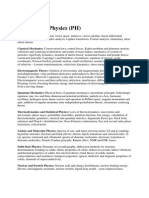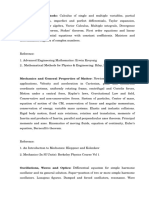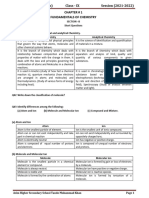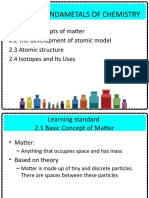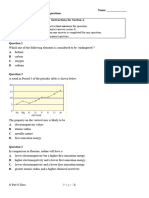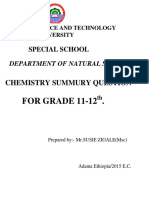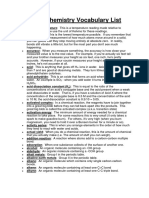0 ratings0% found this document useful (0 votes)
57 viewsRutu Gate PDF
Rutu Gate PDF
Uploaded by
Ruturaj MendhegiriThis document outlines the key topics covered in a physics curriculum, organized into 8 sections:
1) Mathematical physics concepts like vector spaces, matrices, and tensor analysis.
2) Classical mechanics principles including Lagrangian and Hamiltonian dynamics, central forces, and relativity.
3) Electromagnetic theory including Maxwell's equations, electromagnetic waves, and radiation.
4) Quantum mechanics postulates, the Schrodinger equation, angular momentum, perturbation theory, and scattering.
5) Thermodynamics and statistical physics laws, ensembles, phase transitions, and Bose-Einstein condensation.
Copyright:
© All Rights Reserved
Available Formats
Download as PDF, TXT or read online from Scribd
Rutu Gate PDF
Rutu Gate PDF
Uploaded by
Ruturaj Mendhegiri0 ratings0% found this document useful (0 votes)
57 views2 pagesThis document outlines the key topics covered in a physics curriculum, organized into 8 sections:
1) Mathematical physics concepts like vector spaces, matrices, and tensor analysis.
2) Classical mechanics principles including Lagrangian and Hamiltonian dynamics, central forces, and relativity.
3) Electromagnetic theory including Maxwell's equations, electromagnetic waves, and radiation.
4) Quantum mechanics postulates, the Schrodinger equation, angular momentum, perturbation theory, and scattering.
5) Thermodynamics and statistical physics laws, ensembles, phase transitions, and Bose-Einstein condensation.
Original Title
Rutu gate.pdf
Copyright
© © All Rights Reserved
Available Formats
PDF, TXT or read online from Scribd
Share this document
Did you find this document useful?
Is this content inappropriate?
This document outlines the key topics covered in a physics curriculum, organized into 8 sections:
1) Mathematical physics concepts like vector spaces, matrices, and tensor analysis.
2) Classical mechanics principles including Lagrangian and Hamiltonian dynamics, central forces, and relativity.
3) Electromagnetic theory including Maxwell's equations, electromagnetic waves, and radiation.
4) Quantum mechanics postulates, the Schrodinger equation, angular momentum, perturbation theory, and scattering.
5) Thermodynamics and statistical physics laws, ensembles, phase transitions, and Bose-Einstein condensation.
Copyright:
© All Rights Reserved
Available Formats
Download as PDF, TXT or read online from Scribd
Download as pdf or txt
0 ratings0% found this document useful (0 votes)
57 views2 pagesRutu Gate PDF
Rutu Gate PDF
Uploaded by
Ruturaj MendhegiriThis document outlines the key topics covered in a physics curriculum, organized into 8 sections:
1) Mathematical physics concepts like vector spaces, matrices, and tensor analysis.
2) Classical mechanics principles including Lagrangian and Hamiltonian dynamics, central forces, and relativity.
3) Electromagnetic theory including Maxwell's equations, electromagnetic waves, and radiation.
4) Quantum mechanics postulates, the Schrodinger equation, angular momentum, perturbation theory, and scattering.
5) Thermodynamics and statistical physics laws, ensembles, phase transitions, and Bose-Einstein condensation.
Copyright:
© All Rights Reserved
Available Formats
Download as PDF, TXT or read online from Scribd
Download as pdf or txt
You are on page 1of 2
PH: PHYSICS
Section 1: Mathematical Physics
Linear vector space: basis, orthogonality and completeness; matrices; vector calculus; linear differential
equations; elements of complex analysis: Cauchy- Riemann conditions, Cauchy’s theorems,
singularities, residue theorem and applications; Laplace transforms, Fourier analysis; elementary ideas
about tensors: covariant and contravariant tensor, Levi-Civita and Christoffel symbols.
Section 2: Classical Mechanics
D’Alembert’s principle, cyclic coordinates, variational principle, Lagrange’s equation of motion, central
force and scattering problems, rigid body motion; small oscillations, Hamilton’s formalisms; Poisson
bracket; special theory of relativity: Lorentz transformations, relativistic kinematics, mass‐energy
equivalence.
Section 3: Electromagnetic Theory
Solutions of electrostatic and magnetostatic problems including boundary value problems; dielectrics
and conductors; Maxwell’s equations; scalar and vector potentials; Coulomb and Lorentz gauges;
Electromagnetic waves and their reflection, refraction, interference, diffraction and polarization;
Poynting vector, Poynting theorem, energy and momentum of electromagnetic waves; radiation from a
moving charge.
Section 4: Quantum Mechanics
Postulates of quantum mechanics; uncertainty principle; Schrodinger equation; one-, two- and three-
dimensional potential problems; particle in a box, transmission through one dimensional potential
barriers, harmonic oscillator, hydrogen atom; linear vectors and operators in Hilbert space; angular
momentum and spin; addition of angular momenta; time independent perturbation theory; elementary
scattering theory.
Section 5: Thermodynamics and Statistical Physics
Laws of thermodynamics; macrostates and microstates; phase space; ensembles; partition function, free
energy, calculation of thermodynamic quantities; classical and quantum statistics; degenerate Fermi gas;
black body radiation and Planck’s distribution law; Bose‐Einstein condensation; first and second order
phase transitions, phase equilibria, critical point.
Section 6: Atomic and Molecular Physics
Spectra of one‐ and many‐electron atoms; LS and jj coupling; hyperfine structure; Zeeman and Stark
effects; electric dipole transitions and selection rules; rotational and vibrational spectra of diatomic
molecules; electronic transition in diatomic molecules, Franck‐Condon principle; Raman effect; NMR,
ESR, X-ray spectra; lasers: Einstein coefficients, population inversion, two and three level systems.
Section 7: Solid State Physics & Electronics
Elements of crystallography; diffraction methods for structure determination; bonding in solids; lattice
vibrations and thermal properties of solids; free electron theory; band theory of solids: nearly free
electron and tight binding models; metals, semiconductors and insulators; conductivity, mobility and
effective mass; optical, dielectric and magnetic properties of solids; elements of superconductivity:
Type-I and Type II superconductors, Meissner effect, London equation.
Semiconductor devices: diodes, Bipolar Junction Transistors, Field Effect Transistors; operational
amplifiers: negative feedback circuits, active filters and oscillators; regulated power supplies; basic
digital logic circuits, sequential circuits, flip‐flops, counters, registers, A/D and D/A conversion.
Section 8: Nuclear and Particle Physics
Nuclear radii and charge distributions, nuclear binding energy, Electric and magnetic moments; nuclear
models, liquid drop model: semi‐empirical mass formula, Fermi gas model of nucleus, nuclear shell
model; nuclear force and two nucleon problem; alpha decay, beta‐decay, electromagnetic transitions in
nuclei; Rutherford scattering, nuclear reactions, conservation laws; fission and fusion; particle
accelerators and detectors; elementary particles, photons, baryons, mesons and leptons; quark model.
You might also like
- PH PDFDocument2 pagesPH PDFManendra ChaudhryNo ratings yet
- Gate PDFDocument2 pagesGate PDFsachin rawatNo ratings yet
- PH PDFDocument2 pagesPH PDFSwapnil DeyNo ratings yet
- PH: PhysicsDocument2 pagesPH: PhysicsRohiniNo ratings yet
- Syllabus For PhysicsDocument2 pagesSyllabus For Physicsimsc2022uohNo ratings yet
- GATE Physics SyllabusDocument3 pagesGATE Physics Syllabuskumar HarshNo ratings yet
- Section 1: Mathematical PhysicsDocument2 pagesSection 1: Mathematical PhysicsMEERA VNo ratings yet
- Physics Syllabus For GATE 2015Document2 pagesPhysics Syllabus For GATE 2015Sumit KumarNo ratings yet
- Syllabus For Physics (PH)Document2 pagesSyllabus For Physics (PH)sampatelphyNo ratings yet
- Syllabus For Physics GATE-2013Document2 pagesSyllabus For Physics GATE-2013ImranNo ratings yet
- ChemistryDocument2 pagesChemistryArvind SinghNo ratings yet
- PH Syllabus GATE 2013Document2 pagesPH Syllabus GATE 2013Anonymous 8pCXXsNo ratings yet
- GATE Syllabus For PhysicsDocument2 pagesGATE Syllabus For PhysicsslkvmNo ratings yet
- 10 Syll Tech Physics 06 04 22Document2 pages10 Syll Tech Physics 06 04 22JASVINDER SINGHNo ratings yet
- Gate2011 PhysicsDocument2 pagesGate2011 Physicsmahee321No ratings yet
- CSIR-UGC National Eligibility Test (NET) For Junior Research Fellowship and Lecturer-Ship Physical SciencesDocument3 pagesCSIR-UGC National Eligibility Test (NET) For Junior Research Fellowship and Lecturer-Ship Physical SciencesMaruthiNo ratings yet
- NET Syllabus PDFDocument3 pagesNET Syllabus PDFrgdfrNo ratings yet
- Syllabus For PHD & M. Phil (Physics) at AMUDocument3 pagesSyllabus For PHD & M. Phil (Physics) at AMUSyed AsadNo ratings yet
- Set SyllabusDocument3 pagesSet SyllabusTrilok AkhaniNo ratings yet
- CSIR-UGC National Eligibility Test (NET) For Junior Research Fellowship and Lecturer-ShipDocument3 pagesCSIR-UGC National Eligibility Test (NET) For Junior Research Fellowship and Lecturer-Shipchanjaneyulu9No ratings yet
- Subject: Physical Sciences Code No.: 02 Gset Syllabus: Mathematical Methods of PhysicsDocument3 pagesSubject: Physical Sciences Code No.: 02 Gset Syllabus: Mathematical Methods of PhysicsTandel RahulNo ratings yet
- CSIR-UGC National Eligibility Test (NET) For Junior Research Fellowship and Lecturer-Ship Physical SciencesDocument7 pagesCSIR-UGC National Eligibility Test (NET) For Junior Research Fellowship and Lecturer-Ship Physical SciencesAbhik SarkarNo ratings yet
- CSIRDocument3 pagesCSIRAloke RajkishoreNo ratings yet
- 16-Physical Sciences - SyllabusDocument3 pages16-Physical Sciences - SyllabusUmair AnsariNo ratings yet
- NET QuestionsDocument3 pagesNET QuestionsSouvik DasNo ratings yet
- Physics SyllabusDocument3 pagesPhysics SyllabusAmit YadavNo ratings yet
- AP RCET 2019: SyllabusDocument3 pagesAP RCET 2019: SyllabusEswara SaiNo ratings yet
- CSIR NET Physical Sciences SyllabusDocument4 pagesCSIR NET Physical Sciences Syllabuskumar HarshNo ratings yet
- A.P. State Eligibility Test - 2012: Physical SciencesDocument3 pagesA.P. State Eligibility Test - 2012: Physical SciencesSashil ReddyNo ratings yet
- Physics: Physics Engineering Syllabus For UPSC Main ExaminationDocument4 pagesPhysics: Physics Engineering Syllabus For UPSC Main ExaminationSam SamsNo ratings yet
- Physics: Physics Engineering Syllabus For UPSC Main ExaminationDocument4 pagesPhysics: Physics Engineering Syllabus For UPSC Main ExaminationPrince KesharwaniNo ratings yet
- Physics Syllabus UKPSCDocument3 pagesPhysics Syllabus UKPSCBiswajeet MishraNo ratings yet
- Css Course OutlineDocument10 pagesCss Course OutlineUmar IsrarNo ratings yet
- CSIR-UGC National Eligibility Test (NET) For Junior Research Fellowship and Lecturer-Ship Physical SciencesDocument3 pagesCSIR-UGC National Eligibility Test (NET) For Junior Research Fellowship and Lecturer-Ship Physical SciencesR MuniramNo ratings yet
- PH SyllabiDocument2 pagesPH SyllabiSakshi SinghNo ratings yet
- JEST Syllabus 2014 RevDocument2 pagesJEST Syllabus 2014 RevsreejuslNo ratings yet
- Physics Syllabus For Main ExaminationDocument8 pagesPhysics Syllabus For Main ExaminationsarfarajansariNo ratings yet
- IIt jamDocument2 pagesIIt jamgagandeeprathour.rdrNo ratings yet
- IIT JAM Physics SyllabusDocument3 pagesIIT JAM Physics SyllabusYogandre SinghNo ratings yet
- SyllabusDocument4 pagesSyllabusshrikant channeNo ratings yet
- Physics Syllabus For IIT-JAMDocument2 pagesPhysics Syllabus For IIT-JAMchowxopunjyotihandiqueNo ratings yet
- JAM SyllabusDocument4 pagesJAM SyllabusNaveen KuntarNo ratings yet
- IIT JAM Physics SyllabusDocument2 pagesIIT JAM Physics SyllabusHarshit TiwariNo ratings yet
- State Eligibility Test MP SET - 2018 Physical Sciences (Code No. - 15) Syllabus Paper - IiDocument3 pagesState Eligibility Test MP SET - 2018 Physical Sciences (Code No. - 15) Syllabus Paper - IiSunny PayasiNo ratings yet
- Physics UPSC SyllabusDocument4 pagesPhysics UPSC SyllabusPrashanth MatetiNo ratings yet
- Physics I. Mathematical Methods of PhysicsDocument2 pagesPhysics I. Mathematical Methods of PhysicskarnabaluNo ratings yet
- Ja, M SyllabusDocument1 pageJa, M Syllabussoumavo147No ratings yet
- IIT JAM Physics SyllabusDocument2 pagesIIT JAM Physics Syllabuskumar HarshNo ratings yet
- Physics (PH) : Mathematical MethodsDocument2 pagesPhysics (PH) : Mathematical MethodsSahidul IslamNo ratings yet
- M.SC Physics (Entrance Test Syllabus)Document2 pagesM.SC Physics (Entrance Test Syllabus)Saroj KumarNo ratings yet
- 142 SylDocument17 pages142 Sylk gNo ratings yet
- 0 Physics SyllabusDocument2 pages0 Physics Syllabusiffat fatima patilNo ratings yet
- Syllabus For The Subject of Physics: Paper - 1 Total Marks: 100 MechanicsDocument3 pagesSyllabus For The Subject of Physics: Paper - 1 Total Marks: 100 MechanicsvahidzafarNo ratings yet
- JAM 2020syllabiDocument1 pageJAM 2020syllabiyash bhatnagarNo ratings yet
- Info E Book-36-37Document2 pagesInfo E Book-36-37Saikat SenguptaNo ratings yet
- Physics Syllabus For PMSDocument2 pagesPhysics Syllabus For PMSBilal GhaffarNo ratings yet
- CHM021 Atomic ModelsDocument6 pagesCHM021 Atomic ModelsMarie Angeline BautistaNo ratings yet
- Chapter 4 - ChemistryDocument9 pagesChapter 4 - ChemistryHakim Abbas Ali PhalasiyaNo ratings yet
- Fundamentals of Electrical Engineering - Vol 1 - Direct CurrentDocument141 pagesFundamentals of Electrical Engineering - Vol 1 - Direct CurrentRobert MaxwellNo ratings yet
- Chemistry Class IX Session 2022-23Document64 pagesChemistry Class IX Session 2022-23yk931286No ratings yet
- GEASDocument11 pagesGEASRobert E XanaduNo ratings yet
- 9,4 WKBDocument2 pages9,4 WKBKevinHdezNo ratings yet
- Serway 6 e Problems 24Document13 pagesSerway 6 e Problems 24Iqra DadaNo ratings yet
- Matter and Atomic Structure 2020Document51 pagesMatter and Atomic Structure 2020caesar ljnkjtppNo ratings yet
- 3 Inorg Org-Chemistry Edited Content-CompilationDocument115 pages3 Inorg Org-Chemistry Edited Content-CompilationKent TutorNo ratings yet
- Atomic Theory TestDocument8 pagesAtomic Theory TestShilpy UmapatiNo ratings yet
- Pulsars and High Density Physics: Ntony EwishDocument10 pagesPulsars and High Density Physics: Ntony EwishpirotteNo ratings yet
- Chemistry WorksheetDocument68 pagesChemistry WorksheetFaya MohammadNo ratings yet
- The Electronic Structure of MatterDocument5 pagesThe Electronic Structure of MatterFatima DariaNo ratings yet
- 25 Nuclear Physics: OutlineDocument21 pages25 Nuclear Physics: OutlineeltytanNo ratings yet
- Form 5 Science Term 1 Exam 24 With Ans KeyDocument12 pagesForm 5 Science Term 1 Exam 24 With Ans KeyAdrianNo ratings yet
- Hotel Engg I SEMDocument79 pagesHotel Engg I SEMPankaj SharmaNo ratings yet
- IGCSE 2.1 2.3 Atomic Structure 2021 4 PDFDocument18 pagesIGCSE 2.1 2.3 Atomic Structure 2021 4 PDFAlexis RJNo ratings yet
- An Introduction To Free Energy and Free Gravity Machines Rev 00 DDocument204 pagesAn Introduction To Free Energy and Free Gravity Machines Rev 00 Dpeterfoss791665No ratings yet
- LAS Physical-Science Week-1Document11 pagesLAS Physical-Science Week-1Shekaina Faith Cuizon LozadaNo ratings yet
- Nuclear Chemistry Upper LevelDocument42 pagesNuclear Chemistry Upper LevelGroverNo ratings yet
- Science (Mains MCQ Part-2)Document24 pagesScience (Mains MCQ Part-2)Rajat KumarNo ratings yet
- Edexcel IAL Physics Unit 5 October 2021 Question PaperDocument32 pagesEdexcel IAL Physics Unit 5 October 2021 Question PaperEffendi Jabid Kamal100% (2)
- 1 - Basic Chemistry Vocabulary ListDocument12 pages1 - Basic Chemistry Vocabulary ListJoshep Petrus CopperNo ratings yet
- Random Document of Physics Definitions For LC 2024Document12 pagesRandom Document of Physics Definitions For LC 2024bobby alexanderNo ratings yet
- SPM Chemistry 2017: AnswersDocument4 pagesSPM Chemistry 2017: AnswersLam Kah Lam KahNo ratings yet
- Prep.1 - Final Revision - 2020 First Term - MR - Ahmed ElBashaDocument46 pagesPrep.1 - Final Revision - 2020 First Term - MR - Ahmed ElBashaAlaa Hendawai100% (1)
- Chapter 21 Nuclear Physics Exercise Short QuestionsDocument4 pagesChapter 21 Nuclear Physics Exercise Short Questionsmursaleen100% (2)
- CH 2 Essential Chemistry For BiologyDocument53 pagesCH 2 Essential Chemistry For BiologyStalyn Tejada HernandezNo ratings yet
- Nuclear ChangeDocument59 pagesNuclear ChangeKo NwayNo ratings yet
- Objectives and Plan For Igcse PhysicsDocument17 pagesObjectives and Plan For Igcse PhysicsCarole ThamiNo ratings yet








